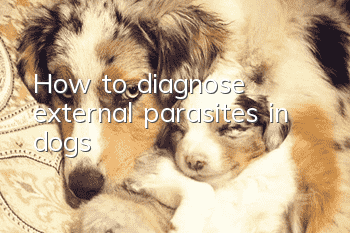How to diagnose external parasites in dogs

External parasites generally live on the surface of the dog's ears, coat and skin and are vectors for transmitting various diseases. Since parasites are prone to repeated infections, there is currently no feasible way to completely eliminate them. Therefore, the most effective way to deal with internal and external parasites is regular deworming.
How to identify external parasites:
Extensive hair removal during non-moulting season.
Scratching or biting the body.
Play outdoors frequently and interact with other small animals.
Common external parasites:
Flea:
Fleas are small, wingless, jumping insects that live on dogs and feed on blood. Their shells are hard and can withstand weights ninety times greater than their body weight. They are good at jumping and can jump over distances 350 times their body length. In addition to sucking blood, fleas are also the vector of deadly infectious diseases such as plague.
Scratching, rubbing and biting the coat, causing hair loss, hair breakage and abrasions;
In severe cases of skin abrasion, fluid may leak out, or even suppurative wounds may form;
Tick:
Ticks (pí) are also called ticks, commonly known as dog beans. They lie dormant on grass and plants. When not sucking blood, small ticks are only as big as dried sesame seeds. After sucking blood, they are about the size of plump soybeans, and large ones can be as big as a fingernail.
They have a keen sense of smell and are very sensitive to the odor of animal sweat and carbon dioxide. They can sense it when they are 15 meters away from the host. They will wait passively and take the initiative to attack. Once they come into contact with the host, they will climb up.
A tick bite emits anesthesia, and the dog feels no pain when it stings or sucks blood.
Tick bites must be removed promptly, otherwise it will cause high fever, headache, fatigue, and muscle aches
Lice:
Lice parasitic on dogs not only suck blood, but also make the host itchy and unbearable, and can transmit many important human and animal diseases. The lifespan of a louse is about 6 weeks. Each female louse lays about ten eggs a day. The lice eggs can adhere firmly to the hair or clothes of people and animals. After about eight days, they hatch into larvae and bite and suck blood immediately. , after about two or three weeks, they can grow into adults after three molts.
Itching: Itching is the main symptom, but the intensity varies among individuals.
Bugs or eggs: Small bugs can be found at the roots of hair follicles, which are light black, gray-white or red (sucking blood).
Canine scabies mite:
Scabies is an itchy parasite of dogs, wolves and foxesWith skin diseases, dogs often rub or scratch their skin and become infected secondary to it.
Small nodules occur, especially where the skin is thin, and small blisters and even pustules can be seen.
The skin is thick, the hair falls off, and the surface is covered with scabs. When the scabs are removed, they appear bright red and moist.
Demodex:
Canine demodicosis is a skin parasitic disease in dogs caused by the Demodex mite. Also known as canine trichocystis or canine fat mange. It is a common and stubborn skin disease.
Canine Demodex mostly parasitizes in the eyes, ears, lips and hairless areas on the inside of the front legs of dogs. It mostly lives in hair follicles and rarely in sebaceous glands. In severe cases, the mites can live in the lymph nodes and other tissues of dogs. Insects can even be found in the ear canal and between the toes of dogs. Systemic Demodex infection is often caused due to reduced immune function.
It is usually localized demodicosis, with hair loss on the affected area in the early stages of infection
The alopecic lesions of generalized demodicosis are widespread and can occur throughout the body.
How to deworm your dog:
Topical anthelmintics can effectively prevent fleas, ticks, lice and other external parasites.
Comb the dog's back hair in reverse direction and spray from a distance of 10-20cm
Comb along the hair to make the liquid contact the skin and back hair evenly
- What should you do if your dog is aggressive? What are the causes of aggressive dog behavior and how to correct it!
- What's going on when a puppy vomits?
- What should I do if my dog loses a lot of hair in summer?
- How should you feed your dog? Teach you how to feed your dog food correctly and scientifically
- Common dog allergy symptoms and allergens
- How to train a dog to sleep in his own kennel? Train your dog to get used to sleeping in the kennel!
- The puppy can’t bark, it can only grunt.
- When should dogs be vaccinated?
- How to treat diarrhea in puppies? How to treat diarrhea in dogs!
- Symptoms and treatments for patellar translocation in dogs



